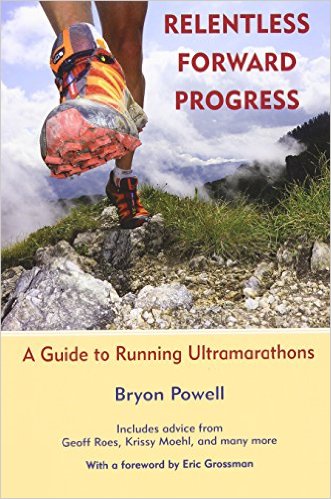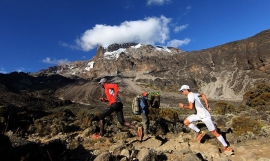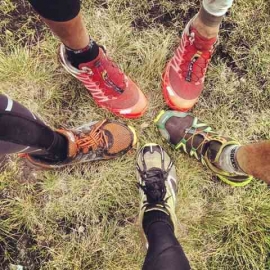Relentless Forward Progress: A Guide to Running Ultramarathons
Marathons have become too easy for some runners. What was once the pinnacle of achievement in a runner's life is now a stepping stone for extraordinary adventure in ultramarathoning. The number of ultrarunners--those running distances of 50k (31 miles), 50 miles, 100k (62 miles), or 100 miles--is growing astronomically each year.
Dean Karnazes' Ultramarathon Man and Chris McDougall's Born to Run have inspired tens of thousands to try these seemingly superhuman distances. But to date, there has been no practical guide to ultramarathoning. Now, Bryon Powell has written Relentless Forward Progress, the first how-to manual for aspiring ultrarunners. Powell covers every aspect of training for and racing ultra distances. Along the way, more than a dozen elites and experts, including Geoff Roes, Krissy Moehl, Michael Wardian, Dave Mackey, and David Horton, provide invaluable advice on running ultramarathons. By its conclusion, this encyclopedic volume prepares runners for going farther than they have ever gone before and, in the process, shows them that they are capable of the "impossible."
Relentless Forward Progress: A Guide to Running Ultramarathons Review
"I can think of nothing that would give me more confidence going into my first ultramarathon than having read this book. Nothing is left out." --Matt Fitzgerald of Competitor Running
"I think it's the perfect thing to give an aspiring ultrarunner, a friend who is curious about what you do, or anybody new to crewing. I'm going to keep a few copies handy for sure." --Scott Dunlap of A Trail Runner's Blog
About Relentless Forward Progress: A Guide to Running Ultramarathons Author
Bryon Powell is a former Washington, DC, attorney who left his job to devote himself to running ultramarathons full time. He publishes the popular trail running and ultrarunning website iRunFar.com, and competes in ultras nationwide. His articles have also been published in Outside, Running Times, Trail Runner, Competitor, andUltraRunning. Bryon is a contributing editor at Trail Runner and is an advisory board member of the American Trail Running Association. He lives in Park City, Utah. As a runner, he has twice placed in the top ten at the Leadville 100 ('06 & '09), twice won the under-30 age group at the Western States 100 ('05 & '06), and was part of the first American team to place in the top three at Morocco's Marathon des Sables ('09).
SO YOU WANT TO RUN AN ULTRAMARATHON!
What Is an Ultramarathon?
What is an ultramarathon anyway? Does it require you to run 100 miles over mountain trails in a race such as the Western States Endurance Run or to suffer through 135 road miles in the furnace-like heat of the Badwater Ultramarathon? No. Simply, an ultramarathon is any race longer than the marathon’s 26 miles and 385 yards.
If you’ve completed a marathon and have run a few additional yards before, during, or after the race, then you’ve completed an ultramarathon. If you’ve taken a wrong turn on a long training run and, through a combination of running and walking, have covered more than 26.2 miles, then you, too, could call yourself an ultra-marathoner.
Still, while both of the above scenarios technically make you an ultramarathoner, it would be somewhat disingenuous to call yourself one after such an effort. As you learn after spending time around other ultramarathoners, the sport is built upon community and the “spirit of the sport,” rather than self-recognition and technicalities.
With that in mind, there’s a second, implicit criterion that should be met before calling yourself an ultramarathoner: the intent to complete an ultra distance. Secondarily and with a nod to the disfavor of technicalities in ultrarunning, the intended distance should be an appreciable distance longer than the marathon. Sorry, but setting out with the aim to run 26.3 miles just doesn’t sit right.
For most runners, 50-kilometer (31.1-mile) races are the gateway into “ultras,” as ultramarathons are commonly known. Those seeking to test themselves with a first ultramarathon at the shorter end of the race spectrum are in luck, as the 50k distance is the most frequently raced ultra distance in most locales. To give you an idea of the prevalence of 50ks, in 2010, well in excess of 200 of them were run in the United States, while 60 were run in California alone. Other runners use time-based races of 6- or 12-hour duration to ease into the requisite distance.
To be clear, you need not run a race to have run an ultramarathon. For instance, you could meet up with a running club for an ultra-distance “fat ass” event. Traditionally, fat ass events carry some variation on the disclaimer, “No fees, no awards, no aid, no wimps.” While the disclaimer may make it sound like fat ass events are no place for running a first ultra, many such events do have limited aid, and their non-competitive nature provides even more collegiality than normally found in the friendly world of ultras. If you prefer solitude, create your own first ultra, whether it involves running laps around your neighborhood or a daylong wilderness adventure run.
All that said, most runners prefer to break the ultra barrier in an official race before calling themselves ultrarunners. If you’ve run a marathon, you may understand the inherent feeling of accomplishment of reaching a true finish line. That feeling is repeated in your first ultra. Satisfaction lies in the act of crossing the finish line, receiving a finisher’s award, and forever after being able to say, “I ran my first ultra at XYZ Race.” Before race day, having a race on your calendar keeps you motivated to train when any of a countless number of detractors, from work and family, to weather and illness, threaten to derail it. At the race itself, you have a built-in supply network of aid stations, while volunteers, spectators, and fellow competitors aid you in your journey beyond the marathon.
Why Run an Ultramarathon?
You may still be considering whether or not you want to train for an ultra—or perhaps you’re looking for some reassurance for continuing to do so. While it is unlikely that training for and racing an ultramarathon will be easy throughout, there are many reasons to run an ultra, whether it’s your 1st or 40th.
For starters, if this will be your first ultramarathon, you will experience a journey into the unknown. The ultramarathon represents a new challenge in attempting to run farther than you ever have before. Rest assured that the challenge is both physical and mental. Find out if you have what it takes.
The complicated and unpredictable nature of ultramarathons can, somewhat counterintuitively, help you reconnect with running. Devon Crosby-Helms, winner of the 2008 Vermont 100-miler, suggests, “A good reason to switch from marathons [to ultras] is because in ultras you have to think about more than just splits and ticking off miles at a certain pace. I think it reconnects you with running in a way that marathoning doesn’t.”
Training for and racing ultramarathons also connects you with a new group of friends. Most folks who have crossed over from subultradistance road racing have found a tight-knit but welcoming community. Ultrarunners are often eager to share the trail with anyone dipping his or her toe into the ultra world. Not only are these runners welcoming, they are an invaluable resource. Coach Lisa Smith-Batchen suggests to new ultrarunners, “Find a group of people that are already running on the trails so they can help you.” Likewise, if you’re training for a road ultra, find some folks training for one. Don’t worry if you’re already active in a running club or community; many ultrarunners enjoy the company of multiple running groups. Variety is the spice of life, after all!
American runners spend the vast majority of their running miles pounding the pavement. On the other hand, most North American ultramarathons are run on trails, so getting ready for one is a great excuse to get off the pavement and up into the hills. While you’re up there you might just see spectacular things. Scotty Mills, who has run ultras for more than a quarter century, notes, “The advantages of training for trail ultras over road marathons are the beauty of the trails, the shared trail time in remote areas, and the peaceful feeling of training with the mind-set that you can run forever.”
Running an ultra also provides a great break from competitive pressures, while still giving you a goal to shoot for. It’s easy to get caught up in racing when there are 10,000 runners blasting down the course with you. The smaller fields, longer distances, and variable conditions of ultras help shift your competition from others to yourself. Knowing that others are thinking the same way makes this transition all the easier. Plus, if it’s your first ultra, you’ll set a PR no matter how long it takes you to finish! Finally, as Mills points out, “The training and friends you make in ultrarunning are the real payoffs; the race itself can almost be secondary in importance.”
In attempting to do what so few people have done, you may end up inspiring yourself. “The mind is a very powerful thing, and it’s generally the only thing standing between you and something incredible. You can always do more than you think you can,” suggests ultra-convert Paige Troelstrup. In a similar vein, Leadville Trail 100-mile founder Ken Choulber is often heard reminding runners, “You’re tougher than you think you are, and you can do more than you think you can.” Go find out if Ken is right!
How to Use This Book to Run an Ultramarathon
Whatever your reasons, you’ve come to this book in search of guidance for running an ultramarathon, perhaps your first—and that is what you’ll find. This book begins by providing a basic framework for ultramarathon training. Following this foundation, you will find training plans for 50ks (31 miles), moderate-distance ultras of 40 miles to 100k (62 miles), and longer ultras of 100 miles and beyond. You’ll also receive a concise education on trail running, a vital component of most ultramarathons.
You’ll learn many lessons en route to a successful ultramarathon. These lessons can be slowly and sometimes painfully self-taught through trial and error. This books aims to shorten the learning process and minimize unneeded suffering by instructing you regarding the ins and outs of ultramarathon hydration and nutrition. Even if you consume the correct fluid and fuel to keep you going on the course, injuries and other challenges can be a quick way to a DNF (did not finish), so they are covered, too. You’ll also want the right gear while training and racing, so that’s covered, as well.
Once you have the tools and training, it’s time to attempt your first ultramarathon. Learn how to prepare for race day and how to approach the race itself. In general, the nutrition, required gear, pacing, environmental conditions, and time on your feet for an ultra differ significantly even from a marathon. In fact, environmental conditions, from blistering heat to breath-stealing altitude, are encountered often enough in ultras to warrant a chapter of their own.
Last but not least, this book offers a few options for exploring and then expanding the world of ultramarathons. Ultras are a social phenomenon; chapter 14 touches on various ways for sharing your journey with others, and points out community-based resources. Finally, the afterword examines variations on the ultramarathon theme, including adventure runs, endurance snowshoeing, fast-packing, and stage races.
Ultrarunning elites and subject area experts have weighed in with their advice to help round out the pages of this book. The widely varying contributions are presented in each runner’s own voice from Krissy Moehl’s inspirational essay on why you should run an ultra to Karl King’s technical insight on hydration and electrolyte balance and from David Horton’s decades-long perspective on how to prepare for your first ultra to Dakota Jones’ fresh take on trail stewardship. I trust you will find their thoughts as valuable as I have.
I picked up a copy of Bryon's book a few weeks back, with the intention of progressing into ultra distance running. I have been running on and off for 3 years and bought the book not really for the training plans, but looking for motivation and inspiration. The book succeeds wonderfully on all counts. The anecdotal articles from well known ultra runners, combined with Bryon's excellent writing style makes this a great buy for both the experienced runner and the beginner alike.
There is a great section on barefoot running technique, and also some excellent nutrition advice. The training schedules are really good, and this book can act well as a textbook to dip in and out of when you want. I've read it from cover to cover twice, and pick it up every day for tips and advice. Well worth buying!!!
Are you the kind of person who likes never ending trial and error, making as many mistakes as possible, or how about learning the hard way? If so, please avoid this book at all costs. It's not for you. On the other hand, do you enjoy gleaning the wisdom of others, making a very difficult task manageable, or being as prepared as you can be for an event that is filled with the unexpected? In that case you've found what you're looking for.
I ran my first ultra about 4 years ago. I thought I had done my homework. I thought I was prepared. I thought wrong. My only complaint about "Relentless Forward Progress" is that it was published about 5 years too late. Had I had this information I might have avoided severe cramping, lightheadedness, and a resounding question that seemed to enter my head at the base of every hill... "What am I doing"?
Bryon has left no stone unturned. In a sport that is so complex, writing a "how to" could be about as perplexing as an ultra it's self. This book could be over-the-top, intimidating, and self-absorbent but it's none of the above. It's a no nonsense, straight forward, non PhD needing look at ultra running unlike I've ever read before.
I could go into all the details that the author covers but the list would be too long. All I'll say is if you want to learn...read it. If you want affirmation that you're on the right path..read it. Or if you're anywhere in between..you guessed it..read it. You'll learn something. I guarantee it.




